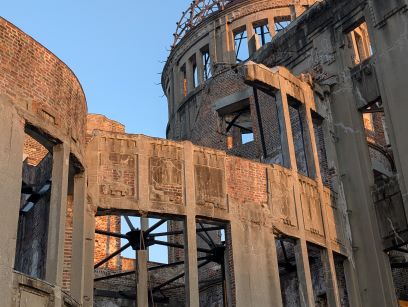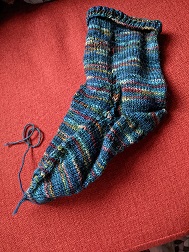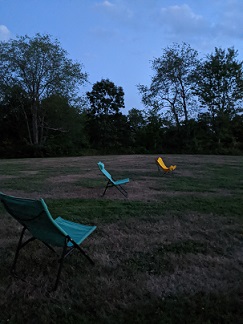On visiting Hiroshima with my family.

Nineteen years ago, I stayed for 10 days in Kyoto with my husband. It was a visit to my childhood dream of Japan: an open-air museum of temples and gardens, the idealized floating world in springtime. We saw fields of purple iris blooming, soaked in a mountainside onsen.
We did not even attempt Tokyo. Nor Hiroshima, although the events of August 1945 had inspired my first novel, The Bowl with Gold Seams, then still in draft form.
This time, our son, Tim, who has his own longtime fascination with Japan, invited us along on his first post-pandemic return. “You must see Tokyo,” he insisted. And I had to see Hiroshima.
Tokyo dazzled, delighted, exhausted, and overstimulated us, from the curated landscape of the Imperial Palace to the virtual sensory reality of Team Lab Planets. Were it not for Tim, we’d still be lost in the labyrinthine subway or swallowed up in the vortex of the Shibuya Scramble intersection.
Friends warned that even beyond Tokyo, Japan would be different from almost 20 years ago. Activated magic-carpet ride of JR Rail Pass in hand, our trio headed south. First stop, the neon playground of Osaka and its castle. Next, Nara, where sacred deer exacted their tariff of cookies as we approached the Todaiji shrine to pay respects to the largest bronze Buddha in the world, strangely stupendous and serene at once.
Back on the train. The electric Shinkansen glides, rice paddies and mountains and towns flash by. Such a tranquil tomorrow-land ride compared to Amtrak: No lurching, no delays. The journey was almost too smooth and swift, not enough time to brace myself for Hiroshima.
We arrived in the pale late-afternoon light of early November. Pulled our bags through bustling, modern streets — very modern, as the entire central city was destroyed by the A-bomb and had to be rebuilt. Friends Connie and Kent Matsumoto, authors of the novel Of White Ashes, based on Kent’s family’s experiences in Hiroshima, Nagasaki, and American internment camps, had told me the Peace Memorial Park is open 24/7 and suggested we go our first evening. Immediately after checking into our hotel, we started out.
Walking along the riverbank, we came upon a rough-cast bronze angel sheltered beneath five graduated tiers of an inverted pagoda. The Memorial Tower to Mobilized Students was built with funds donated by the parents of 7,000 local children conscripted by the Student Labor Service Act. These middle- and high-schoolers were at work on August 6, 1945, in factories or demolishing buildings and gathering debris to create fire-containment zones. A stone plinth beside the angel is draped with ropes of bright origami cranes.
Each at our own pace, separately but together, we followed the path with a small stream of visitors toward the Aioi bridge, the A-bomb’s specific target. Just beneath the rebuilt bridge, a ravaged, skeletal dome caps what remains of the city’s 1905 Industrial Promotion Hall. We sat by the river and the dome before crossing onto Peace Park island.
Quiet groups of middle- and high-school students in ubiquitous, crisp militaristic uniforms (the girls’ backpacks festooned with cuddly animals) posed for pictures, school by school, beside the Flame of Peace and the Children’s Peace Monument, a statue of a girl with upstretched arms, memorializing Sasaki Sadako.
Two years old when the bomb hit her neighborhood, Sasaki survived. Years later, she was one of many diagnosed with cancer associated with radiation exposure. She died at 12, halfway toward her goal of folding 1,000 paper cranes. According to Japanese folk tradition, folding a thousand cranes would’ve ensured her wish to live. Countless cranes have since been folded around the world in her memory and in the collective memory of all who perished in Hiroshima and Nagasaki. The paper crane has become a symbol of both atomic destruction and hope for peace.
Dark fell as we walked among the throngs of students toward an elevated building. The Peace Memorial Museum spans the park like a long, covered bridge with blackened windows. Inside, we walked with the silent crowd through a dark tunnel of rooms, surrounded by photographs and artifacts: a blasted tricycle, a pitted tea kettle, shreds of clothing, an image of a kimono pattern seared onto flesh, fliers and postcards searching for loved ones. Remnants of everyday life, of lives incinerated by manmade apocalypse. Testimony to the blast and the death and suffering that followed immediately and for years after.
The museum closed at seven. Outside on the plaza, an illuminated fountain gleamed. Towering, irregular jets of water shot up and subsided, over and over. We watched until the lights and fountain were extinguished for the night.
Traveling, I keep a record, day by day, in my journal. Otherwise, especially on the move, one day’s memories blur into the next. Sometimes, in Japan, I fell asleep scribbling; those entries end with a scrawl down the page. I did not even try to write that night, nor the following morning.
The next day, we went, as Connie Matsumoto had suggested, to the island of Miyajima. An hour’s tram ride through the rebuilt city, then a swift ferry ride into the harbor, it’s a short journey from Hiroshima into the seemingly eternal world of a centuries-old Shinto shrine. Miyajima’s huge vermillion Torii gate floats in the water just beyond shore. At low tide, we walked out beneath this crimson gate. Schoolchildren flung glittering green seaweed at each other.
Miyajima does not erase Hiroshima’s impact; rather, it accentuates it. Back in the city, steeping in the hotel’s top-floor onsen, I peered out at the sparkling lights of resilient Hiroshima below. Later, I tried to write about the strange juxtaposition of impressions: the blasted A-Bomb Dome, the floating Torii gate. I’m still trying.
Returned home, I perused my husband’s prized first edition of John Hersey’s Hiroshima. Tucked inside the dust jacket is a clipping, the 2011 obituary for Akihiro Takahashi. Fourteen years old when the bomb dropped on his neighborhood, he spent his life bearing witness, including service as director of the Peace Memorial Museum. He did not live to see the Nihon Hidankyo, the grassroots movement of Hibakusha, survivors of the A- and H-bombs, awarded the 2024 Nobel Peace Prize. But the obituary closes with Takahashi’s words, speaking for them all:
“We live to hand down the awful memories to future generations and represent the silent voices of those who died in misery and terror.”
Hiroshima is a portal to the past, a sacred place — desecrated, devastated, and consecrated. No matter how many miles distant from the place and years distant from the event, we must listen to those silent voices, heed the message and admonition of their suffering and their lives. Listen and continue listening when the last Hibakusha are gone. Listen now and in all the time we hope is to come.
[Photo by Tim Pskowski.]
Ellen Prentiss Campbell’s collection of love stories is Known By Heart. Her story collection Contents Under Pressure was nominated for the National Book Award, and her debut novel, The Bowl with Gold Seams, won the Indy Excellence Award for Historical Fiction. Her novel Frieda’s Song was a finalist for the Next Generation Indie Book Award, Historical Fiction. Her column, “Girl Writing,” appears in the Independent bi-monthly. For many years, Campbell practiced psychotherapy. She lives in Washington, DC, and is at work on another novel.

